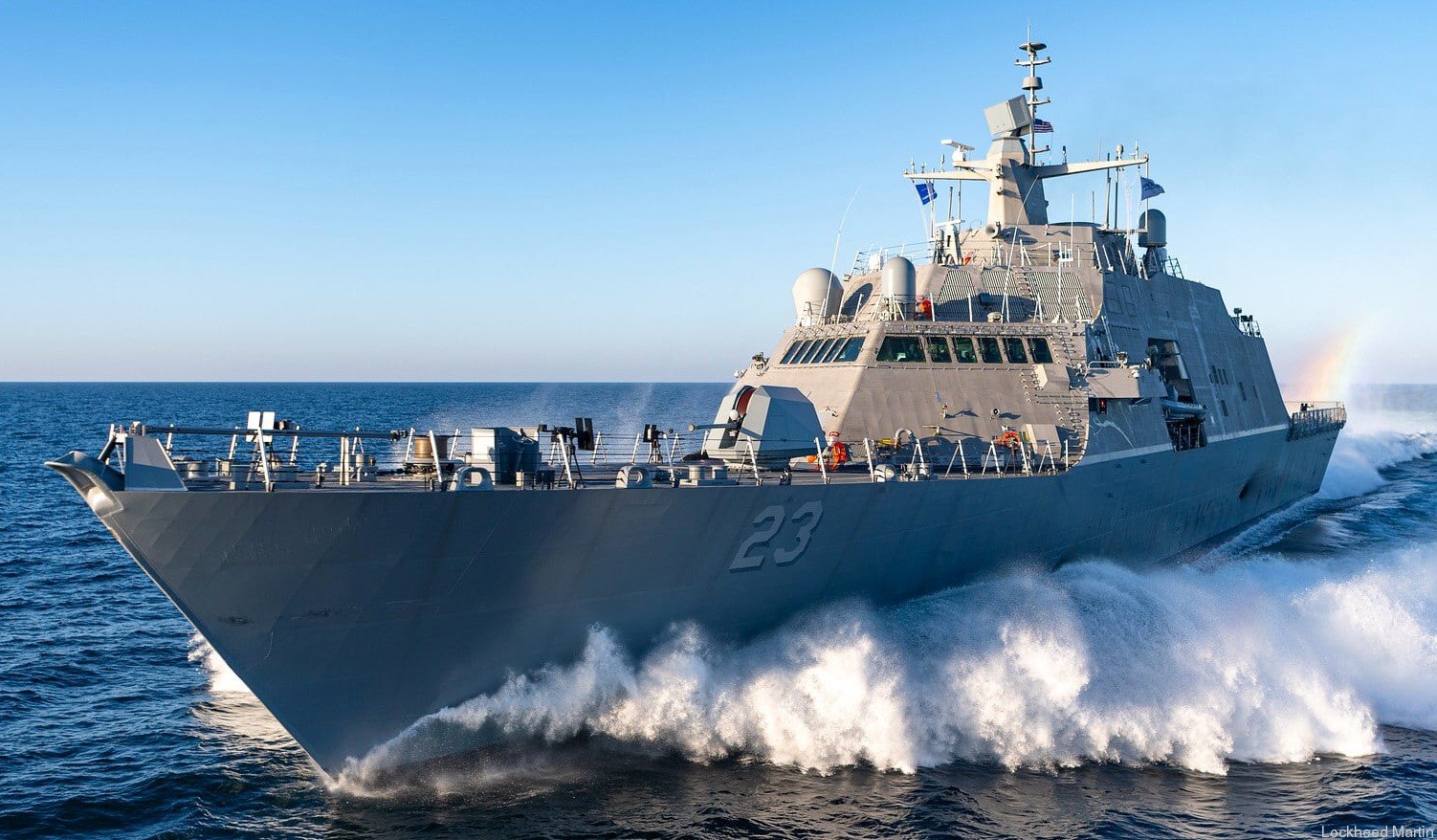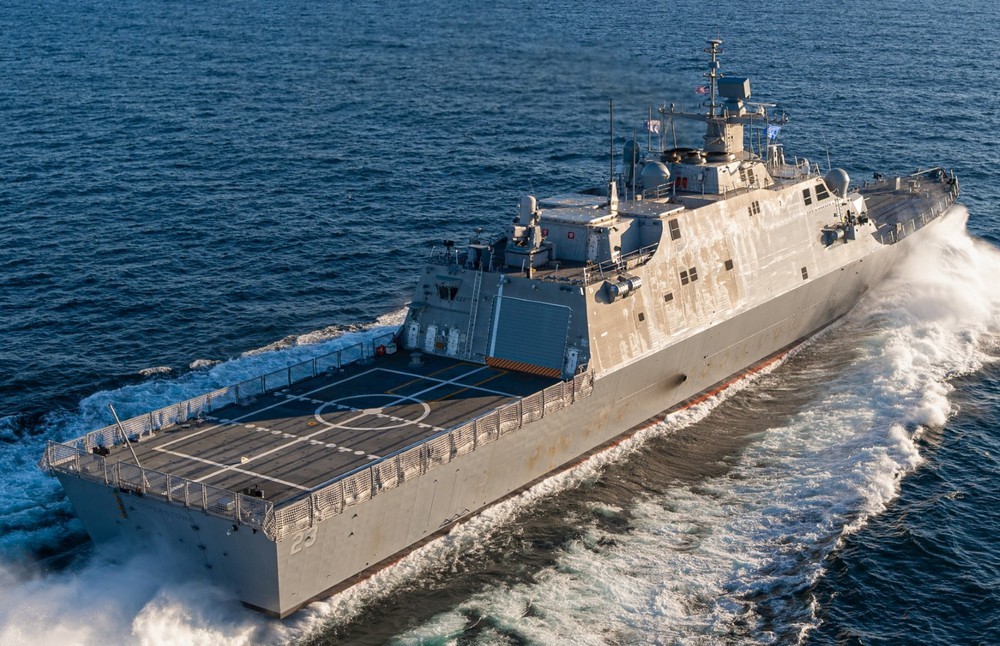
Lockheed Martin Awarded $78,530,376 Cost-Plus-Fixed-Fee Modification for Navy Contract N00024-18-C-2300 to Evaluate Combat Ship Program Progress Work will be performed in Hampton, Virginia; Moorestown, New Jersey; Washington, D.C.; and Marinette, Wisconsin, and is expected to be completed by October 2021. Fiscal 2015 shipbuilding and conversion (Navy) funding in the amount of $13,148,817 will be obligated at time of award and will not expire at the end of the current fiscal year. The U.S. Navy’s Sea Systems Command, Washington, D.C., is the contracting activity.
The Freedom-class is one of two classes of littoral combat ship programs, built for the United States Navy. The Freedom-class was proposed by Lockheed Martin as a “proven design” and by Fincantieri (project) through the Marinette Marine as a contender for the Navy’s Littoral Combat Ship (LCS) program.
The Freedom-class is a monohull design based on a steel semi-planing monohull and has an aluminum superstructure. It is 377 feet (115 meters) in length, displaces 3,500 metric tons (3,400 long tons), and can achieve speeds of up to 47 knots (87 km/h; 54 mph).
Lockheed Martin Freedom-class (Littoral Combat Ship Program) The design incorporates a large, reconfigurable seaframe to allow rapidly interchangeable mission modules, a flight deck with integrated helicopter launch, recovery, and handling systems, and the capability to launch and recover boats (manned and unmanned) from both the stern and side. The flight deck is one and a half times larger than that of a standard surface ship, and uses a Trigon traversing system to move helicopters and other payloads to the side of the ship for storage. The ship has two ways to launch and recover various mission packages: a stern ramp and a starboard-side door near the waterline. The stern ramp is used for launching and recovering 7-meter (23 ft) Rigid-hulled Inflatable Boats (RHIBs), unmanned vehicles, and for personnel transfer. The ship’s modular bay has a 3-axis crane for positioning mission packages, and a passage to the flight deck. The mission bay is 15.8 meters (52 ft) long, 5.1 meters (17 ft) wide, and 4.11 meters (13.5 ft) high. Automated launch and recovery systems are used for the launching and recovery of the 11-meter (36 ft) rigid hull inflatable boat (RHIB), and a .50-caliber gun mount is provided topside. The Flight-Plus mission package lessens the required personnel to operate significantly.
The core crew is 40, plus an aviation detachment for operating the embarked aircraft, a mission package crew, and a stern-camp detachment to operate and deploy the embarked boats. Automatic launching and recovery systems are used for the launch and recovery of the 11-meter (36 ft) rigid hull inflatable boat (RHIB), and automated launch and recovery systems are used for the launching and recovery of the surface connectors and for securing connectors or vehicles on the ship’s deck. Duration testing of the class leader, two ships’ company’s complete testing, but with the In-Service Core Capability (ISCC) design or functional baseline. During testing of the class lead ship, two ships’ companies complete testing to prove design and functional baseline of up to 55 vessels.
The ship’s hull has a molded beam of 40 feet (12 meters), unusual for a ship of this length, which gives greater stability. Automated launch and recovery systems are used for the launching and recovery of the 11-meter (36 ft) rigid hull inflatable boat (RHIB), and automated launch and recovery systems are used for the launching and recovery of the surface connectors and for securing connectors or vehicles on the ship’s deck. The core crew is 40, plus an aviation detachment for operating the embarked aircraft, a mission package crew, and a stern-camp detachment to operate and deploy the embarked boats.
The Freedom-class has a modular design with easily reconfigurable mission packages. A Rolling Airframe Missile launcher is located on the starboard side, while a fixed .50-caliber gun mount is provided topside. The core crew size of the Freedom-class vessel is small in comparison to other ship classes, but workloads are shifted to more-specialized support and modular crew detachments. Automatic launch and recovery systems are used for the launching and recovery of the 11-meter (36 ft) rigid hull inflatable boat (RHIB), and automated launch and recovery systems are used for the launching and recovery of the surface connectors and for securing connectors or vehicles on the ship’s deck.
The core crew is 40, plus an aviation detachment for operating the embarked aircraft, a mission package crew, and a stern-camp detachment to operate and deploy the embarked boats. Automatic launch and recovery systems are used for the launching and recovery of the 11-meter (36 ft) rigid hull inflatable boat (RHIB), and automated launch and recovery systems are used for the launching and recovery of the surface connectors and for securing connectors or vehicles on the ship’s deck.
The Freedom-class has a modular design with easily reconfigurable mission packages. A Rolling Airframe Missile launcher is located on the starboard side, while a fixed .50-caliber gun mount is provided topside. The core crew size of the Freedom-class vessel is small in comparison to other ship classes, but workloads are shifted to more-specialized support and modular crew detachments. Durability testing of the class leader, two ships’ companies complete testing, but with the In-Service Core Capability (ISCC) design or functional baseline. During testing of the class lead ship, two ships’ companies complete testing to prove design and functional baseline of up to 55 vessels.









